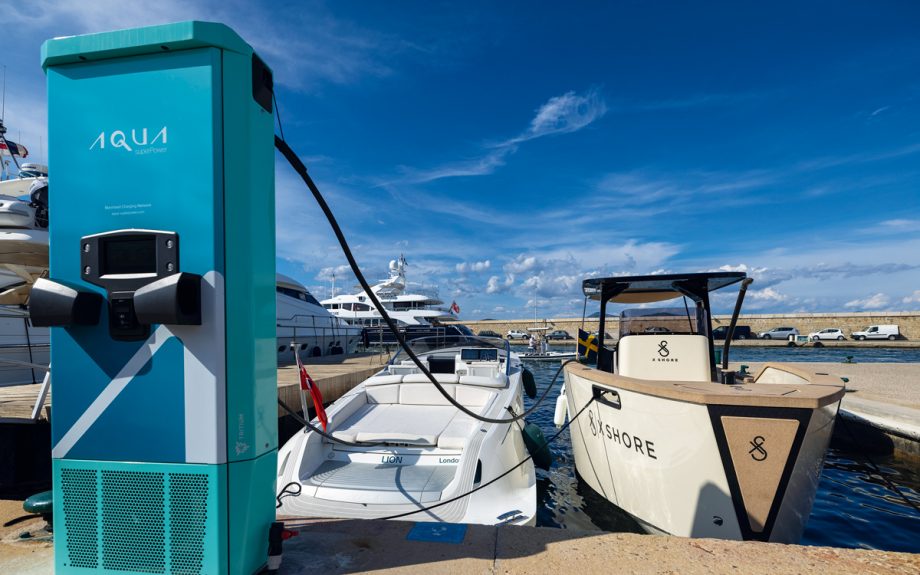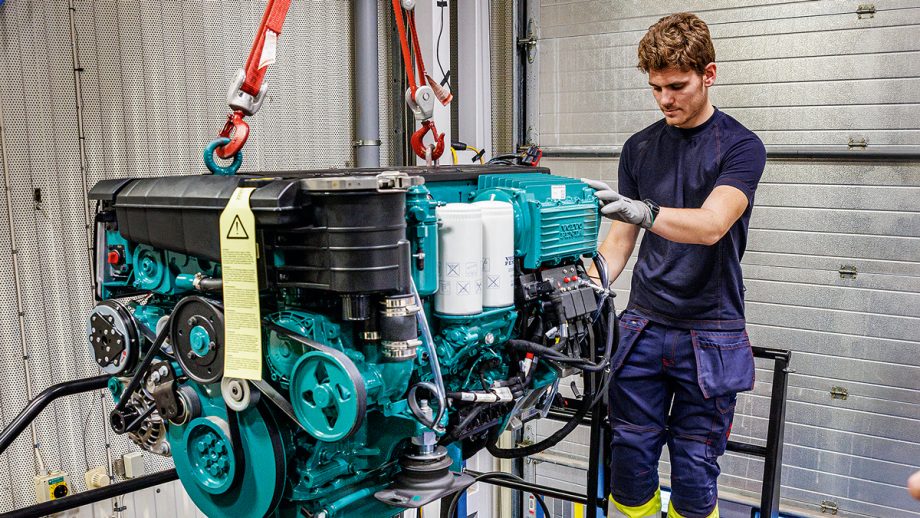Best hybrid diesel electric boats: The best of both worlds?

Offering silent, emissions-free cruising at displacement speeds and full-throttle performance on the open water, the best hybrid diesel electric boats can do it all…

Electric boats have spread throughout the boating world at a rapid pace over the past few years, but what if you’re not ready to ditch the diesel just yet? Well, that’s where the best hybrid diesel electric boats come in.
Not to be confused with the best hybrid bay boats, these hybrid electric boats combine a traditional diesel engine with an electric motor and so are able to potter along in full electric mode before switching on the diesel engine when you need that extra power to punch a tide.
This not only saves on fuel costs, but is also kinder to the environment and quieter for all those on board. Still not convinced? Check out our round-up of the best hybrid diesel electric boats to see all the big name players investing in this technology…
10 of the best hybrid diesel electric boats

The Azimut Seadeck 6 is due to launch at the 2024 Düsseldorf Boat Show
Azimut Seadeck 6
Based on ultra-efficient planing hulls with a 40% carbon fibre content to reduce weight, the Azimut Seadeck range will feature Volvo’s forthcoming diesel-electric hybrid drivetrains and roof-mounted solar panels.
This will allow them to run at slow speed on battery power alone but with diesel engines for faster speeds and longer journeys. Azimut says this will still enable them to reduce CO2 emissions by as much as 40% over an average year of mixed use.
First to arrive will be the Azimut Seadeck 6, a hardtop/coupé design with an expected LOA of around 60ft and a worldwide debut at the 2024 Düsseldorf Boat Show, followed by the Azimut Seadeck 7, a sportsfly design of approximately 72ft, at the 2024 Cannes Yachting Festival.
Read more about the Azimut Seadeck 6
Article continues below…

Electric boats: When will the boating world be ready to ditch the diesel?

Volvo Penta D4 Hybrid first look: Is this the future of boat propulsion?

The first Bering 145 was launched in Antalya in 2022 and named M/Y Heeus
Bering 145
With a full displacement steel hull of just over 500 tonnes and an aluminium superstructure, the Bering 145 combines a fuel capacity of 95,600 litres with a parallel hybrid drive system for a range of 12,000nm at a cruising speed of 9 knots.
Under conventional diesel power the range is still a staggering 5,000nm at 8 knots; the maximum speed is 15 knots. The yacht’s hybrid system drives the propellers via electric motors that are powered by a bank of batteries that are recharged by variable speed generators.
There’s enough power on tap that this superyacht can enter or leave its berth in silence using electric-only mode.
Read more about the Bering 145

The BGM75 features exterior styling from Zuccon International
Bluegame BGM75
Due to be launched at the 2023 Cannes boat show, the all-new Bluegame BGM75 measures 74ft 4in long but sports a relatively narrow beam (for a powercat) of 26ft 7in. It claims this will allow it to offer the same volume and performance as a semi-displacement 90ft monohull while using smaller, more efficient engines.
The slimmer proportions should also deliver a more sea-kindly motion than a typical wide beam motor catamaran, which can have a rather jerky motion in beam seas, as well as a less boxy profile and lower berthing costs.
The BGM75’s ultra-efficient hull has been developed by London-based French naval architect Philippe Briand, who says it will use around 50% less fuel than a comparable volume monohull.
Powered by relatively modest twin Volvo Penta 600hp IPS800s, the semi-displacement hulls should deliver a top speed of around 21 knots with a sustained fast cruise of 18 knots. Bluegame is also claiming it will be one of the first boats fitted with Volvo’s new hybrid diesel electric powertrain, allowing it to cover short distances on battery power alone.
Read more about the Bluegame BGM75

At £1.8m, the Falcon 10m Limousine is not just one of the best hybrid diesel electric boats, but it’s also one of the priciest
Falcon Tenders 10m limousine
Falcon Tenders is a relative newcomer in the yachting industry, and the company, founded by Mark Pascoe (previously of Pascoe International), has taken a novel approach with their superyacht tenders.
Their first two launches were not commissioned by clients but were built on speculation to display the company’s capabilities. And as if that wasn’t brave enough, the first model also boasts a hybrid powertrain.
Powered by a pair of 270hp Hyundai V6 engines supplemented by 20-kilowatt electric motors, this setup allows for cruising using the combustion engines at speeds of up to 40 knots. At slower speeds of around 8-9 knots, the electric motors seamlessly take over, enabling noiseless and fume-free manoeuvres in marinas or near motherships for up to an hour.
Read more about the Falcon Tenders 10m Limousine

The Hardy 42 was already one of the best British-built trawler boats, now its one of the best hybrid diesel electric boats too…
Hardy 42 Hybrid
The Hardy 42 has been around in previous guises for quite a while now but the combination of a new yard, Falmouth-based Cockwells (builders of the Duchy range of gentleman’s launches), and a commissioning owner with exceptional foresight has resulted in the best iteration yet.
As the name suggests the 42 Hybrid is a diesel-electric hybrid boat that genuinely seems to offer the best of both worlds. Its single diesel 440hp Yanmar engine can deliver a top speed of 16 knots from its comfortable semi-displacement hull form, and a range of 600nm at 12-14 knots.
This makes for effortless passage-making, even in conditions that might challenge faster planing boats, but once you arrive at your destination you can switch into electric boat mode for near-silent cruising at 4-5 knots for 2-3 hours.
The owner of this boat plans to cruise the waterways of Europe, making it the perfect craft for crossing the English Channel or the North Sea under diesel power before letting electric take over once into the more protected inland waters where speed is limited anyway.
Read more about the Hardy 42 Hybrid

The hybrid prototype looks just like any other Jeanneau NC37
Jeanneau NC37 Hybrid
Volvo Penta’s new parallel hybrid system has already been operating successfully for several thousand hours on a wind farm personnel transfer vessel and on a support boat used by arctic surfers.
The fact that it’s performed so well means it’s now been integrated onto a leisure boat for the first time. Jeanneau’s NC37 is a longstanding and well respected family boat. But when you lift up the engine hatch and peer inside, full of gleeful expectation, it all looks oddly commonplace.
What we have in here is a pair of Volvo Penta D4-320s hooked up to DPI Aquamatic Sterndrives. The engines have been shifted forward 25cm, freeing up the space for a pair of 60kW electric motors.
Read more about the Jeanneau NC37 Hybrid

The Leen 72 has the range to cross any ocean in the world non-stop
Leen 72
Neel Trimarans has been championing the bluewater sailing trimaran niche virtually unchallenged for the past dozen years. However, recently it has started making
waves in the world of motor boats, too, with an all-new range of power-trimarans under the Leen brand.
The first Leen 72 has a hybrid installation. There is one single diesel engine – a 330hp Cummins QSL 9 – that’s hooked up to a straight shaft and prop and resides in its own palatial engineroom in the middle of the lower deck.
Plus there are independent electric motors, shafts and props in both floats. Essentially the wing motors have three roles – easy manoeuvring in harbour, emissions-free capability (for a limited range) and as back-up propulsion in case of a fouled prop or engine issue.

The improved Silent 62 is based on the successful 60 model
Silent 62
Due to launch at the 2023 Cannes Yachting Festival, the Silent 62 takes the proven blueprint of the Silent 60 to create the smallest tri-deck catamaran in the range, with three different layout options for the top deck.
With the largest 2 x 340kW motors and a 286kWh battery pack the Silent 62 can cruise at 6-8 knots pretty much non-stop if there is enough sunshine to feed the 17kWp solar panels.
Silent estimates that the 62 will have a daily cruising range of 100nm on solar power alone. If the weather isn’t playing ball there is always the 150kW diesel generator to fall back on, fed by fuel tanks of up to 1,600 litres.

Diesel electric hybrid power should give the Sunreef Ultima 55 a top speed of 35 knots
Sunreef Ultima 55 Open
Powercat builder Sunreef Yachts is launching an exciting new range of fast, sporty powercats with hybrid propulsion, starting with this Sunreef Ultima 55.
Sunreef is not revealing much detail about the much-vaunted hybrid propulsion package at this stage, save to say that it will be powered by twin 350kW electric motors fed by a combination of a powerful battery bank and diesel generators.
This should deliver a top speed approaching 35 knots and a range of around 180nm at 25 knots. The battery bank can be charged directly from shore power or the onboard generators as well as being constantly topped up by solar panels on the wheelhouse roof.
Read more about the Sunreef Ultima 55 Open

Edgy styling is a deliberate attempt to liven up the usual bland design of powercats
Widercat 92
The new owners of Italian superyacht builder Wider Yachts are relaunching the brand with a fresh focus on hybrid powercats. The first new model, the Widercat 92, is a 242 gross tonne tri-deck model that sneaks in under the 24m load-line limit.
The diesel electric hybrid powertrain comprises twin Danfoss 583kW electric thrusters fed by a combination of twin 390kW variable-speed FPT diesel generators, solar panels on the roof and a lithium-ion battery bank.
In normal mode Widercat 92 owners can expect a cruising speed of 12 knots and a top speed of around 15 knots. In calm seas with the generators running, a range of 1,600nm at eight knots should be possible or 2,400nm at six knots.
The Widercat 92 can also cruise in zero-emissions electric only silent mode for around 27nm at six knots. At anchor the solar panels should also provide sufficient hotel loads for up to 24 hours without firing up the generators or around 12 hours at night from the house batteries alone.
Read more about the Widercat 92
This article Best hybrid diesel electric boats: The best of both worlds? appeared first on Motor Boat & Yachting.
Source: https://www.mby.com/features/best-hybrid-diesel-electric-boats-128012





